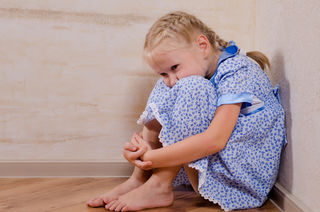Anxiety
10 Better Ways to Help an Anxious Child Calm Down
Telling anxious kids to "calm down" or "buck up" doesn't work. Here's what does.
Posted March 24, 2019 Reviewed by Lybi Ma
Ever been at a loss as to how to help your child when he/she is anxious?
For example:
- A child arrives at a birthday party excited but becomes too worried to walk through the door
- A child runs out of the doctor’s office as the nurse approaches with a needle/shot
- A child refuses to get out of the car when he/she doesn’t know anyone at a new camp or activity
- A child feels nauseous about performing on stage, trying out for an activity, or taking a test
- A child is terrified that they will be injured by a storm or tornado.
It may seem like nothing you say or do helps.

When kids are anxious, they often experience a fight, flight, or freeze (acute stress) response, which is a physiological reaction in response to something they perceive as scary. The body's sympathetic nervous system is activated, triggering the release of adrenaline and noradrenaline, which increases heart rate, blood pressure, and breathing rate. After the threat is gone, it takes 20-60 minutes for the body to return to normal levels.
Some kids experience anxiety more than others. About 15 to 20 percent of kids are born with a more anxious temperament (the amygdala part of their brains is more reactive to novel stimuli from the start).
Anxious kids may scream, shake, run away, be especially quiet, act silly, hide, cling, have tantrums, or act out to avoid a stressful environment or event.
At times, parents make the mistake of trying to reason with kids or talk them out of their fears (without first addressing the acute physiological factors at play). They may say things like "calm down," "stop crying," or "try to be brave now." Because anxiety can look like defiance or acting out (e.g. running out of the room), parents may even punish anxious kids or give them time-outs.
However, brain research suggests that it's extremely difficult (if not impossible) for kids to think with logic or control their behavior until they step out of fight/flight/freeze mode.
Here are 10 science-based ways parents can gently help children calm down, regain a sense of safety, and manage their anxiety.
1. Stimulate the Vagus Nerve
Stimulating your child’s vagus nerve (located on both sides of the voice box) can interrupt fight or flight mode and send a signal to his/her brain that “he/she is not under attack”.
Ways to stimulate the vagus nerve include:
- Chew gum
- Sing or hum
- Breathe slowly—with roughly equal amounts of time breathing in and out
- Eat a piece of dark chocolate (which is also a parasympathetic regulator)
- Gargle with regular water
2. Breathe
When kids are anxious, they tend to take rapid, shallow breaths that come directly from the chest. Taking slower, deeper breaths (from the abdomen or diaphragm) can relax them.
Try having kids:
- Blow bubbles
- Blow into a pinwheel
- Slowly blow out “candles” on your fingertips
- Have a whistling contest
- Imagine that with each breath she takes in, her body becomes filled slowly with a soothing color, aroma, sound, light, or warmth
- Breathe in for three, hold for three, out for three
- Breathe “in through the nose, out through the mouth”
3. Cross the Midline
Crossing the midline, or moving one's hands, feet, and eyes across and to the other side of the body can help reset the brain.
Research suggests that when you move your arms or legs across the center of your body, the brain hemispheres are activated and work together so you can think with both logic and emotion.
Try:
- Cross marches, child marches in place while touching their opposite knee (right arm touch left knee)
- Windmills, have your child reach out to the side with their arms straight; then pretend that they are a windmill by moving their arms in a circle while crossing across the middle of their body
- Wipe the table with one hand
- Walk-in figure eight. Draw a large side-to-side figure eight with sidewalk chalk for your child, and have her/him walk the figure eight
4. Heavy Work
Heavy work activities (any activities that push or pull against the body) provide input to a child's muscles and joints, increase a child's focus and attention, and center a child.
Doing wall pushups, carrying a backpack, pushing a vacuum, climbing a jungle gym, carrying a pile of books, or pulling a wagon, can help kids calm and regulate their emotions.
5. Name It
Dr. Daniel Siegel suggests that when kids are in fight or flight mode, their emotions are raging and they have “lost touch with their upstairs brain.” He recommends helping kids “name it to tame it” by assisting them in telling the story about what’s upsetting them.” By talking, kids will use their left brain to make sense of their experience and feel more in control. At times, Siegel notes, kids will need to engage their bodies (see above) before they are able to talk things out.
6. Narrow Focus
Parents can help kids “look at one thing, hear one thing, or think about one thing” because research suggests that relaxation can be achieved by narrowing attention.
Use guided imagery/visualization by asking kids (when they are not anxious) to think of a "happy place" or "happy symbol."
- "Imagine a place where you feel totally comfortable and happy, a favorite place you have been, somewhere you have seen, or completely made up.
- What do you see there? What do you hear? What do you smell?
- How does your body feel?"
When kids are anxious, have them imagine their happy place.
Kids may also narrow their focus by coloring or playing with a glitter wand.
7. Make a Plan
Making a plan (MAP) or My Anxiety Plan (MAP) can help your child learn how to tolerate rather than eliminate anxiety. One child worried about thunderstorms when her mother was out of town for work. The girl made a plan to text her mom and string a necklace out of plastic beads with her babysitter whenever she heard thunder. (She called these her “thunder beads” and eventually looked forward to making them). Another child starting with a new baseball team made a plan that if he got anxious, he would chew gum and take a break by walking to the bathroom and back.
8. Use Humor
Research suggests that exposure to humor can significantly reduce anxiety. Humor can distract, relax muscles, reframe, heal, and release endorphins that combat stress.
Try playing a goofy game with your child, watching slapstick cartoons together, reading a funny book together, or telling jokes like:
- What has four wheels and flies? A garbage truck!
- Can a kangaroo jump higher than the Empire State Building? Of course! The Empire State Building Can’t Jump!
- Why did the math book look so sad? Because it had so many problems!
9. Use a Ritual: Before/After/During
Research suggests that rituals act as "stability anchors" that help kids relieve stress. Consider providing a consistent ritual or choice before, during, or after an anxiety-provoking situation. One parent kept a stash of Superman comic books for her child to read at the doctor's office. Another took his child for a slushy after every tough appointment. A nurse in a blood draw clinic had children choose a silly shirt and hat to dress a large stuffed gorilla before a visit. Another nurse had them pick a joke out of a jar of paper strips to tell her when they came in. Another had children “be the DJ” and choose one of six CDs to play. Rituals help kids feel a sense of control over tough situations.
10. Reflect
If kids are anxious yet make it through an activity anyway, helping them reflect can build resilience and strength for the next time.
Ask:
- On a scale of 1 to 10, how hard was it?
- Was it harder or easier than another tough activity?
- What one thing helped you get through it okay?
- What one thing did you end up enjoying about the activity?
Or:
- Picture yourself looking through a hole in the wall at yourself when you were stressed
- What do you notice about yourself?
- What message would you give yourself in that moment?
Facebook image: Alfira/Shutterstock
LinkedIn image: Monkey Business Images/Shutterstock




